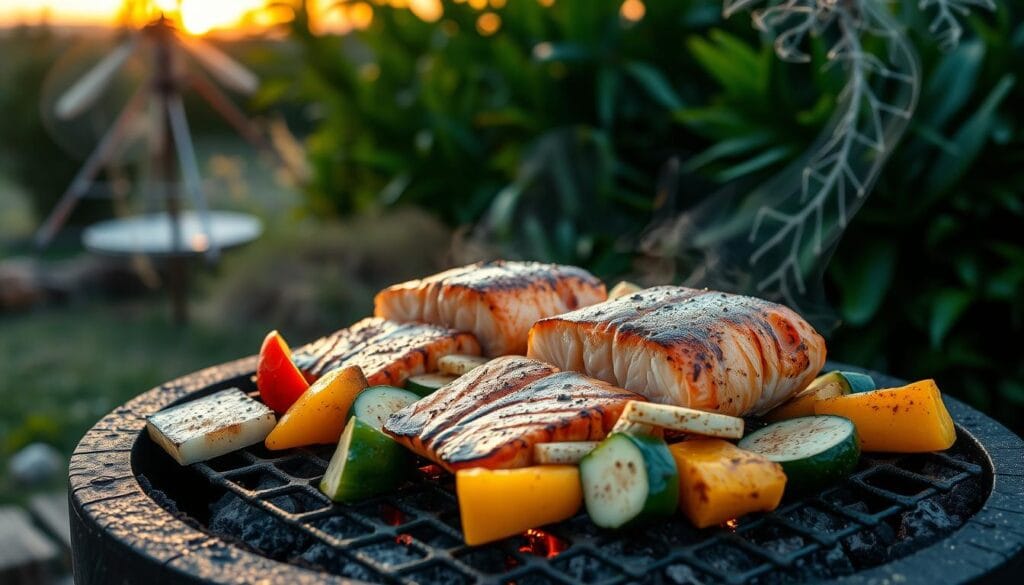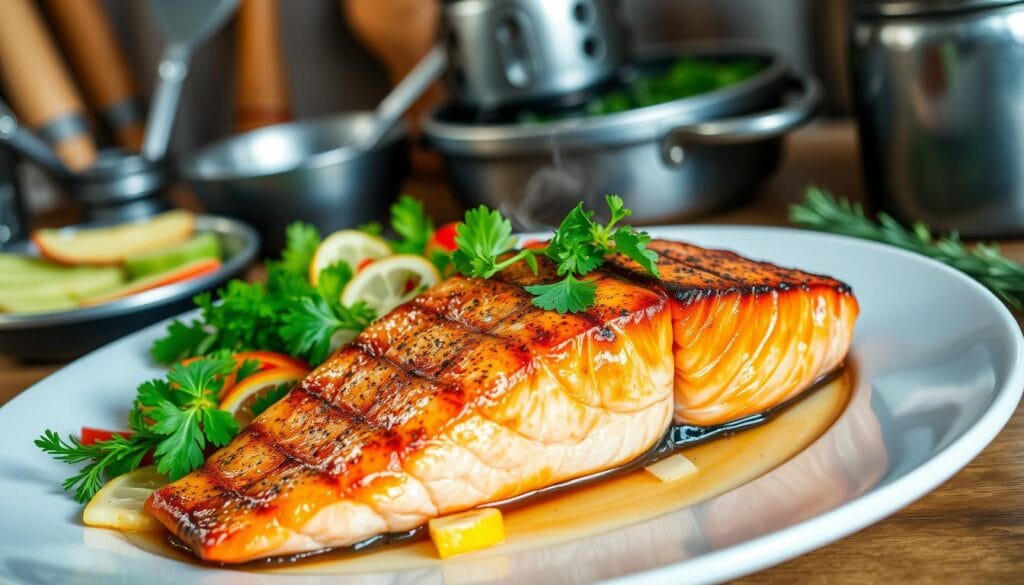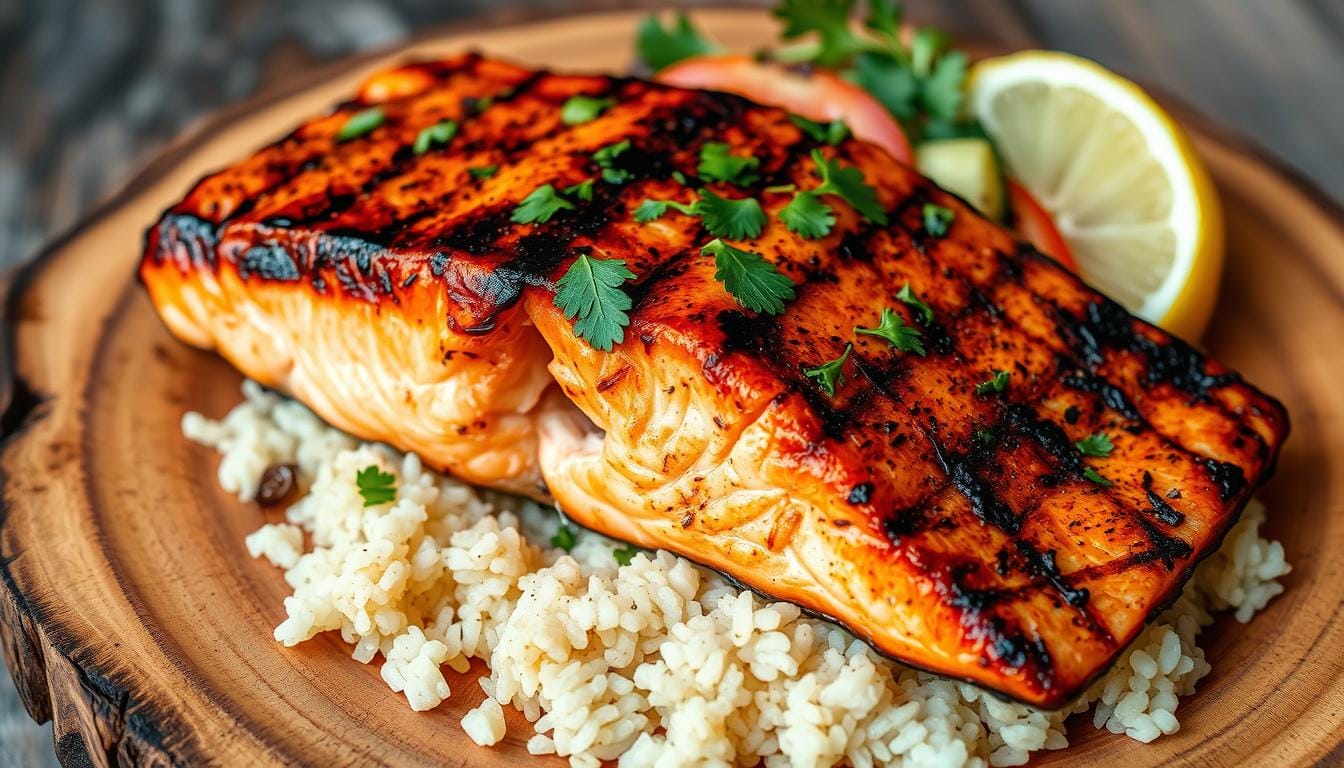Every culinary adventure starts with a discovery that changes your kitchen. For me, salmon kama was that discovery. It’s a hidden gem in Japanese cuisine that makes home cooking special.
Salmon kama is the prized collar section of the fish, right behind the head and gills. It’s known for its rich, buttery texture and intense flavor. Thanks to its higher fat content, seafood lovers love it because it’s moist and tender.
Exploring salmon kama Japanese cooking techniques opens up a world of possibilities. Chefs and home cooks love it for its taste and versatility. Whether you grill, broil or air fry it, salmon kama makes your kitchen feel like a restaurant.
Salmon kama’s growing popularity in Western cuisine shows a wider appreciation for Japanese seafood methods. It’s a must-try for food lovers looking for unique and flavorful dishes.
Table of Contents
What is Salmon Kama and Its Origin in Japanese Cuisine
Salmon kama is a special cut in Japanese cooking. It’s found behind the fish’s head and gills. It’s known for its rich taste and soft texture.
The term “kama” means the collar section. This part has the most fat and juicy meat.
In Japanese cooking, every fish part is used. This turns what others might see as waste into a gourmet dish. Salmon kama is a prime example, offering great taste and nutrition.
Traditional Preparation Methods
Salmon kama is prepared in several traditional ways:
- Grilling over high heat to crisp the skin
- Broiling to keep it moist and enhance flavors
- Serving with daikon oroshi (grated radish) for freshness
Cultural Significance in Japanese Dining
Fish collars are important in Japanese food culture. They show respect for ingredients and aim to bring out the best flavors. Chefs pick and prepare these cuts to highlight the fish’s natural taste.
| Fish Collar Type | Characteristic | Typical Preparation |
|---|---|---|
| Salmon Kama | Fatty, tender | Grilled or broiled |
| Hamachi Kama | Delicate, light | Broiled with simple seasoning |
| Tuna Kama | Robust flavor | Grilled with sea salt |
Different Types of Fish Collars
Salmon kama is special, but Japanese cuisine has many fish collar types. Each has its taste and cooking method. This lets food lovers try new flavors and cooking styles.
The Rich Nutritional Benefits of Fish Collar Cuts
Salmon kama is a hidden gem in seafood nutrition. It’s often overlooked but is packed with health benefits. It has the right amount of calories and is a great source of protein.
The nutritional profile of salmon kama is impressive. Its fat content is not just for taste. It’s full of omega-3 fatty acids. These fats are good for your heart, reduce inflammation, and help your brain function.
- Rich in omega-3 fatty acids
- High-quality protein source
- Contains essential vitamins and minerals
- Lower cost compared to traditional salmon cuts
Here are the key nutrients in salmon kama:
| Nutrient | Benefit | Quantity per 100g |
|---|---|---|
| Omega-3 Fatty Acids | Heart & Brain Health | 2.3g |
| Protein | Muscle Development | 19g |
| Vitamin D | Bone Health | 360 IU |
| Selenium | Immune Support | 36mcg |
Choosing salmon kama means you’re picking a food that’s good for you. It’s not just tasty but also packed with nutrients. It’s a smart choice for those who want to eat well and enjoy their meals.
How to Select and Buy Quality Salmon Kama
Finding the best salmon kama means knowing where to look and what to check. Whether you love seafood or enjoy cooking at home, learning to pick and buy top-notch salmon can improve your meals.
Where to Find Fresh Salmon Kama
You can find salmon in several places:
- Specialty fish markets
- Asian grocery stores
- Online seafood retailers
- Gourmet food shops
Price Points and Value Considerations
Salmon kama is a tasty and affordable treat for seafood fans. Prices usually fall between $8 and $15 per pound, based on quality and source. When looking for salmon near you, compare prices to find the best deal.
Smart Shopping Tips
When buying salmon, look for these signs of quality:
- Bright orange color means it’s fresh
- Firm, smooth texture
- Clean, ocean-like smell
- No brown spots or leaking fluids
Storage Recommendations
To keep salmon fresh, store it in your fridge’s coldest spot. Use it within 1-2 days. For longer storage, freeze it right away and use it within three months.
Pro tip: When buying salmon online, make sure delivery happens when you’re home. Also, think about getting shipping insurance to protect your order from spoilage.
Essential Preparation Steps for Perfect Salmon Kama
Preparing salmon needs careful attention. Your recipe will stand out with these steps. The goal is to bring out the rich flavors of this fish collar cut.
Begin by thawing the salmon if it’s frozen. Give it a day or so to thaw in the refrigerator. This ensures it defrosts evenly and keeps its delicate texture.
- Rinse the salmon under cold water
- Pat dry thoroughly with paper towels
- Inspect for any remaining scales or bones
Seasoning is key for your salmon kama recipe. Make a simple yet tasty marinade with:
| Ingredient | Quantity | Purpose |
|---|---|---|
| Mirin | 2 tablespoons | Adds sweet depth |
| Sesame Oil | 1 tablespoon | Enhances nutty flavor |
| Salt | 1/2 teaspoon | Brings out natural taste |
| Black Pepper | 1/4 teaspoon | Adds subtle heat |
Brush the marinade over the salmon for even coverage. Let it rest for 10 minutes to soak up the flavors. This makes your salmon kama truly special.
Pro tip: Preheat your cooking equipment before adding the salmon. Use a grill, broiler, or air fryer for consistent heat. This ensures a perfectly cooked fish collar with crispy edges and tender meat.
Air Fryer Method for Crispy Salmon Kama
Discover how to make your salmon collar crispy with an air fryer. This method turns salmon into a tasty dish with little effort and lots of flavor.
Temperature and Timing Guidelines
To cook salmon collars in the air fryer, you need to know the right temperature and time. The best temperature is 400 degrees Fahrenheit. The salmon’s cooking time is determined by its thickness:
- Thin salmon collars: 6-8 minutes
- Thick salmon collars: 10-12 minutes
- Recommended internal temperature: 145°F
Step-by-Step Air Fryer Instructions
- Preheat air fryer to 400°F
- Pat salmon collar dry with paper towels
- Brush with 1 teaspoon olive oil
- Season with:
- 1 teaspoon sea salt
- ½ teaspoon black pepper
- ½ teaspoon garlic powder
- Place skin-side down in air fryer basket
- Cook for 6-7 minutes
- Flip and cook additional 2-3 minutes
Achieving the Perfect Crispy Skin
For a great air fryer salmon collar, you need crispy skin. Make sure the salmon is dry before cooking. Letting the skin cool for a few minutes after cooking will make it even crisper.
| Cooking Metric | Recommended Value |
|---|---|
| Preparation Time | 5 minutes |
| Total Cooking Time | 13 minutes |
| Serving Size | 2 people |
| Calories per Serving | 275 kcal |
Traditional Broiling and Grilling Techniques

Learning traditional salmon kama recipe techniques can boost your seafood cooking skills. Broiling and grilling are great ways to cook this tasty fish collar. They bring out rich flavors and give a crispy exterior.
Broiling Salmon Kama
When broiling salmon, where you place it matters. Put your rack 6-8 inches from the broiler. Cook for 8-12 minutes until it’s beautifully blistered.
Flip the fish for 2-3 minutes more to crisp the skin perfectly.
Grilling Techniques
Grilling salmon needs careful heat control. Here are the key steps:
- Preheat grill to medium-high heat (around 400-450°F)
- Clean and oil grill grates to prevent sticking
- Cook 4-5 minutes per side
- Look for a golden-brown exterior with slight char marks
Cooking Tips for Perfect Salmon Kama
| Cooking Method | Temperature | Cooking Time |
|---|---|---|
| Broiling | High | 8-12 minutes |
| Grilling | Medium-High | 4-5 minutes per side |
For a real salmon kama recipe, use wild-caught salmon for the best flavor. Pro tip: Marinate your fish in soy sauce, ginger, and garlic for 30-60 minutes before cooking. It will make the taste even better.
The secret to a perfect salmon recipe is watching the cooking time and temperature. You want a crispy outside and a tender, juicy inside.
Classic Japanese Seasonings and Accompaniments
Enjoying salmon with traditional Japanese seasonings and accompaniments is a treat. These additions make your salmon kama experience a journey through authentic Japanese flavors.
Making Daikon Oroshi
Daikon oroshi is a classic Japanese condiment that pairs well with salmon kama. It has a crisp, clean flavor that cuts through the fish’s richness. To make daikon oroshi:
- Select a fresh daikon radish
- Peel and grate using a fine grater
- Lightly press through a mesh strainer to remove excess water
- Serve immediately for maximum freshness
Dipping Sauce Variations
Salmon kama is even better with authentic Japanese dipping sauces. Here are some classic variations:
- Ponzu Sauce: A citrusy, tangy sauce made with yuzu or lemon juice
- Soy-Ginger Dip: Combining dark soy sauce with freshly grated ginger
- Yuzu Kosho: A spicy, zesty condiment with yuzu citrus and chili peppers
Each sauce adds a unique flavor to the salmon kama. It highlights the delicate flavors of this prized Japanese fish cut. Try these accompaniments to find your favorite.
Common Cooking Mistakes to Avoid

Getting the perfect salmon kama recipe right takes precision and care. Many home cooks make big mistakes that ruin the fish’s flavor and texture.
- Overcooking: The biggest mistake is cooking salmon too long. It should stay moist and tender.
- Incorrect temperature: Keeping the heat at medium-high, around 400°F, helps prevent the fish from drying out.
- Ignoring proper seasoning techniques
- Using inappropriate cooking methods
Keeping the right temperature is key for your salmon recipe. Chefs say to cook it to an internal temperature that keeps it moist and flavorful.
| Cooking Method | Recommended Temperature | Cooking Time |
|---|---|---|
| Air Fryer | 400°F | 3-4 minutes per side |
| Broiling | 425°F | 4-5 minutes |
| Grilling | Medium-high heat | 3-4 minutes per side |
Seasoning is crucial for your salmon kama recipe. Don’t overdo it with heavy marinades. Instead, use light seasonings that bring out the fish’s natural flavors.
- Use minimal marinade time (15-20 minutes maximum)
- Avoid acidic marinades that can alter fish texture
- Select seasonings that enhance rather than mask the fish’s flavor
By knowing these common mistakes, you can make your salmon kama recipe amazing. You’ll get a dish that rivals restaurant quality every time.
Conclusion
Exploring salmon kama opens a new world of cooking for home cooks and seafood fans. This often-overlooked fish cut is more than a meal. It’s a way to cook sustainably, maximizing flavor and cutting down on waste. Your adventure with salmon starts with its amazing potential.
Salmon kama is versatile and exciting for both new and seasoned cooks. You can air fry, grill, or broil it, each method revealing unique textures and tastes. By trying different seasonings and cooking ways, you’ll see why it’s a hit with seafood lovers.
Salmon kama also has great nutritional benefits. It’s packed with omega-3s and protein, making it a healthy choice for fish dishes. Its quick cooking and various methods make it easy for anyone to try, helping you stay healthy while exploring new recipes.
As you keep exploring, remember salmon kama is more than a meal. It’s a celebration of eating sustainably, trying new flavors, and enjoying cooking. Your kitchen becomes a place for creativity, where every dish is a chance to make a memorable meal.

